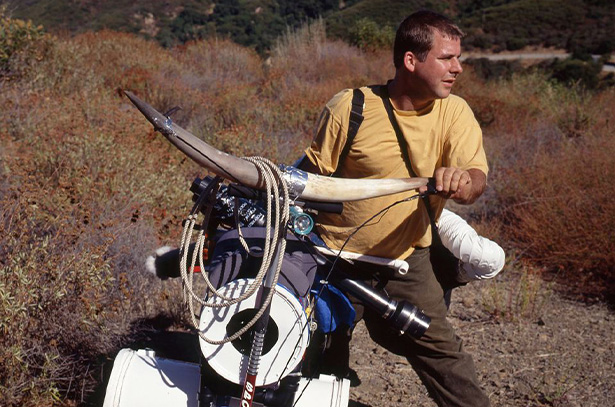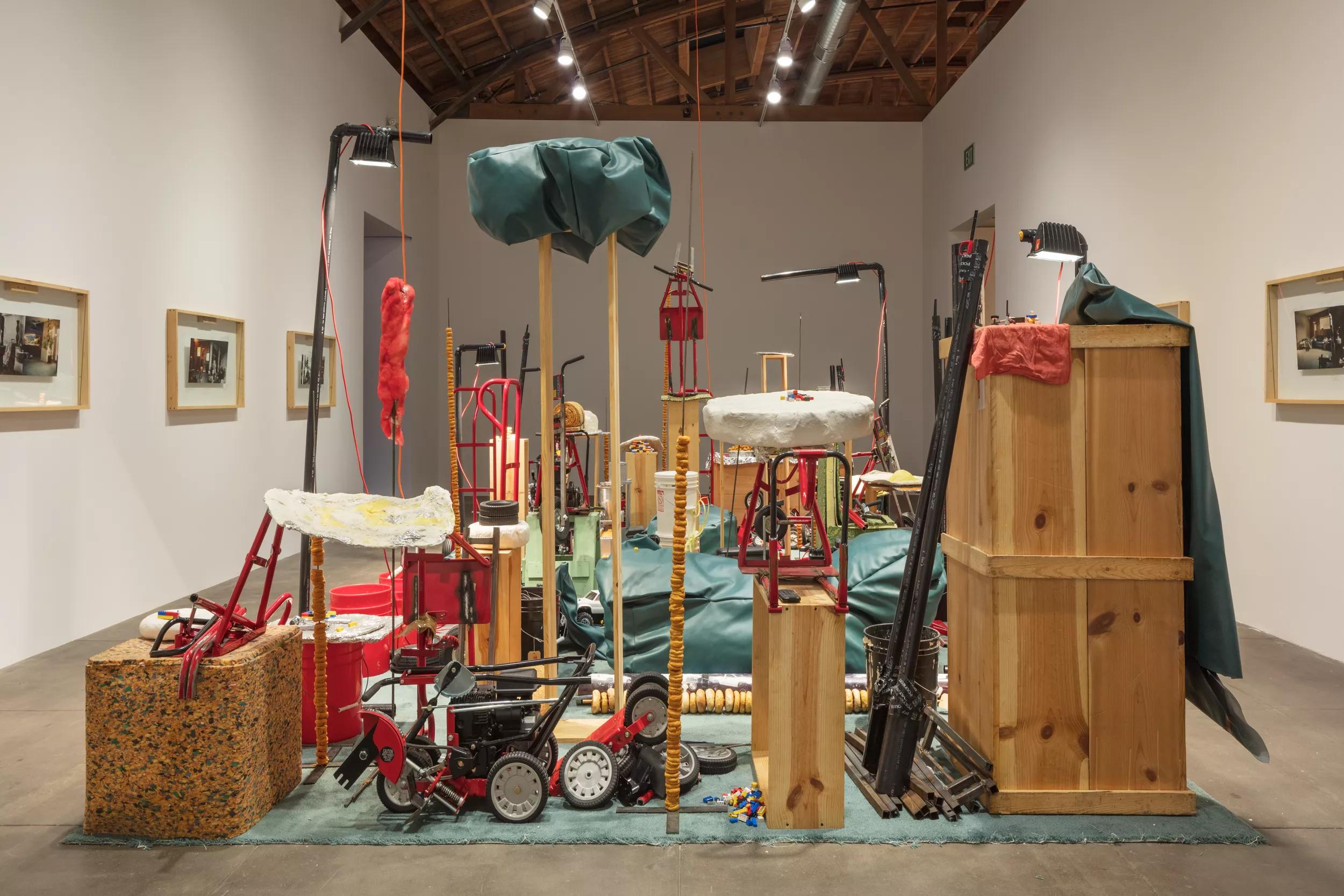Beginning 18 February 2017, Hauser & Wirth Los Angeles presents ‘Jason Rhoades. Installations, 1994 – 2006,’ the first major Los Angeles exhibition devoted to the politically charged, darkly exuberant art of Jason Rhoades. Comprised of six major works spanning the artist’s career, this exhibition constitutes a long-overdue, comprehensive survey in his adopted city. While Rhoades’ groundbreaking installations found early recognition in Europe and New York, the artist spent the entirety of his career in Los Angeles, where he lived and worked until his untimely death in 2006 at the age of 41. The exhibition at Hauser & Wirth Los Angeles is conceived to share and celebrate his unwavering vision of the world as an infinite, corpulent, and lustful universe of expressive opportunity. Assertively pushing against the safety of cultural conventions, Rhoades broke accepted rules of public nicety and expanded the frontiers of artistic opportunity through unbridled, brazenly ‘Maximalist’ works. In short, Rhoades brought the impolite and culturally unspeakable to the center of the conversation.
Organized by Paul Schimmel, ‘Jason Rhoades. Installations, 1994 – 2006’ will remain on view through 21 May 2017. The exhibition will unfold over 28,000 square feet, tracing the evolution of the artist’s vision and methods through career-defining works: ‘Swedish Erotica and Fiero Parts’ (1994); ‘My Brother / Brancuzi’ (1995); ‘The Creation Myth’ (1998); ‘My Madinah. In pursuit of my ermitage...’ (2004); ‘The Black Pussy... and the Pagan Idol Workshop’ (2005), and ‘Tijuanatanjierchandelier’ (2006). ‘Jason Rhoades. Installations, 1994 – 2006’ will be accompanied by a fully-illustrated catalogue released by Hauser & Wirth Publishers. The book will feature a foreword by Paul Schimmel; an essay by Russell Ferguson, Professor in the Department of Art at the University of California, Los Angeles, along with a series of scholarly articles.
About the Exhibition A decade after his death and in a moment of heightened political tension, Jason Rhoades’ radical oeuvre is more relevant than ever. From religion, commerce, sex, and racial and gender stereotypes, to role of the artist himself, no subject was off-limits and taboo was embraced. Rhoades viewed art as a machine set on a continuous feedback loop, delivering something superficially chaotic but replete with hidden references beyond first blush, and his existential quest becomes clearer as one moves around and through his installations. Rhoades considered his separate works as components of one single boundless piece realized over time. ‘If you know my work, you know that it is never finished,’ he once said.
Rhoades completed his art studies at UCLA in 1993, where professors Chris Burden, Nancy Rubins, Charles Ray, Paul McCarthy, and Richard Jackson influenced his highly personal experimentation with performance and sculpture. Rhoades’ culminating accretions of readymades, neon signs, and libidinous imagery mimic the seductive vacuum of capitalist culture. These installations of total experience attract, then repulse, then mystify the viewer, igniting questions that multiply with prolonged exposure to the artist’s work.
The Six Installations
Swedish Erotica and Fiero Parts (1994) Rhoades’ first solo show in Los Angeles, ‘Swedish Erotica and Fiero Parts’ was presented at Rosamund Felsen Gallery in West Hollywood. His only work to specifically reference the urban and cultural landscape of LA, the installation – a yellow world of assembled mundane items such as cardboard, scrap wood, legal pads, and Styrofoam – sent seismic shocks across the local art scene. Rhoades’ deep fascination with Ikea and the act of buying spurred him to create modular set-ups of ‘furniture’ for viewers to navigate. Linking the interior to the exterior with color, Rhoades parked a yellow Fiero car with Ferrari labels in the gallery’s yard – a sculpture and a symbol to Angelenos as both a literal and figural vehicle to freedom.
My Brother/Brancuzi (1995) Rhoades continued to explore installation with ‘My Brother/Brancuzi,’ created for the 1995 Whitney Biennial, his first national museum exhibition. The museum’s setting and history inspired Rhoades to explore the values of Modernism. Juxtaposing his brother’s suburban bedroom with the famous studio of Constantin Brancusi, Rhoades transposed traditional perspectives. Photographs of his brother’s bedroom and Brancusi’s studio line the perimeter of this installation, while quotidian mechanical objects fill its interior: a remote control-operated monster truck, a brakeless mini-bike, and an industrial fryer surrounded by donuts. A rod of stacked donuts alludes to Brancusi’s ‘Endless Column’ and pays homage to Marcel Duchamp’s readymades (Duchamp and Brancusi were considered by Rhoades to be the only true Modernists).
The Creation Myth (1998) ‘The Creation Myth’ is an analytical unmasking of the myth of Man as Creator. The artist sought to understand why, how, and what humans create by exploring Creationist and Evolutionist theories in tandem. The irreverent representation of the human body and brain is structured into levels to suggest our categories of perception: the archetypal, the real, the unconscious and the rebellious. Each of the six nouns in the work’s subtitle (‘The Mind, the Body and the Spirit, the Shit, Prick and the Rebellious Part’) is metaphorically portrayed, while the function of the brain itself unfolds through a calculated combination of readymades and images. A series of stacked tables constitutes the ‘brain,’ in which a ‘train of thought’ – a toy train mounted by a snake’s head and tail – circles. Digestible ‘information’ enters the ‘brain’ in the form of pornography-wrapped logs of wood, representing the physicality of creation. Cut and disseminated, ‘information’ is incessantly processed and reproduced by cameras, mirrors, and computers. Smoke rings erupt from ‘the Asshole,’ a fleeting byproduct of the frenzied machine, a personification of the Spirit, alluding to the pursuit of the ephemeral moment.
My Madinah. In pursuit of my ermitage... (2004) On a drive between LA and Mecca, California, Rhoades conceived a work that would be his own hermitage – or ‘ermitage.’ The result is ‘My Madinah,’ part mosque, part temple: a place of religious seclusion covered in a carpet of towels adjoined by the artist’s Spukaki technique, punctuated by crystals, incense, ceramic donkeys, and camel saddle footstools. Beneath a veritable cloud of 240 neon ‘pussy words’ – such slang terms for female genitalia as ‘Fluttering Love Wallet,’ ‘Cock Pocket,’ and ‘Breakfast of Champions’ – float above the scene. Viewers are invited to lie down and surrender to transmitting light. Formally conflating the visual language of contemporary urban America with the influence of his travels to ancient spiritual sites in the Middle East, Rhoades challenges post-9/11 anti-Islamism on his own terms. Glowing neon bewitches viewers into a charged web of political incorrectness, literally illuminating taboos and hypocrisies.
The Black Pussy… and the Pagan Idol Workshop (2005) ‘Black Pussy’ was originally conceived as a two-part project: the first part, a public bazaar-like, sculptural installation presented in 2005 at Hauser & Wirth London; the second part, a private, ‘invitation-only’ performance that was activated by a series of happenings called ‘Black Pussy Soiree Macramé Cabarets,’ which took place in Los Angeles in 2006. The project was inspired by the intersection of commerce and religion, specifically the ancient pre-Islamic story of the Kaaba. The two parts of ‘Black Pussy’ are comprised of five core elements: Egyptian-made hookah pipes and paraphernalia from a seized shipping container; dreamcatchers purchased on eBay; beaver-felt cowboy hats; a collection of ancient gongshi stones; and ultraviolet neon picture-words depicting slang for vagina. Being shown for the first time since it was made, ‘The Black Pussy… and the Pagan Idol Workshop’ joyously reincarnates 360 banished idols, brazenly attending to our worship of the gods of commerce and spectacle. ‘“The Black Pussy” is my collection of pussy words drawn from African, Creole, Cajun, Ebonics and Hip-Hop dialects,’ Rhoades remarked in February 2006. In his quest for the ‘Ultimate Pussy Word,’ Rhoades amassed over 7,000 terms. His persistent pursuit can be seen as the result: there is no ultimate word for the female genitalia.
Tijuanatanjierchandelier (2006) The final work of the exhibition, ‘Tijuanatanjierchandelier’ (2006) raises questions about consumerism in relation to disparate cultures and classes by exploring tourism in analogous third world border towns: Tijuana, Mexico and Tangier, Morocco. In this installation, culturally significant objects are purged of their traditional function due to the homogeneity of modernization, thus masking differences and easing fears of the first world trespasser. Nearly identical trinkets from Tijuana and Tangier, cities 6,000 miles apart, blend in a network of chandeliers that incorporate 176 Spanish and English neon ‘pussy words.’ To create this work, Rhoades embarked on shopping trips in search of ‘Black Pussy objets d’art,’ transforming a private act of consumption into an adventure in global trade. Imposter designer handbags, sombreros, Moroccan hanging lights, and maracas mingle in ways that divulge and then detach from the cultural myths and stereotypes that tourism has encouraged.
























